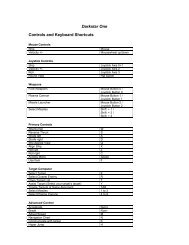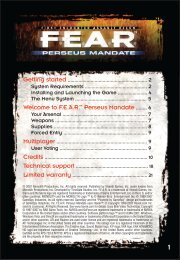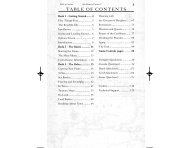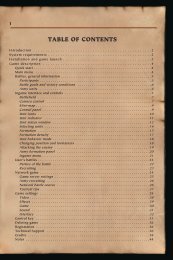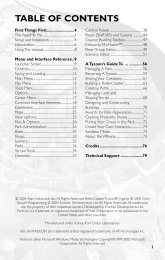Heads-Up Display Modes 35 - Metaboli
Heads-Up Display Modes 35 - Metaboli
Heads-Up Display Modes 35 - Metaboli
Create successful ePaper yourself
Turn your PDF publications into a flip-book with our unique Google optimized e-Paper software.
Air-to-Ground Weapons 97<br />
AIR-TO-GROUND WEAPONS<br />
Air-to-ground weapons come in two categories: guided and unguided. Guided<br />
weapons include air-to-ground missiles and laser-guided bombs. Unguided<br />
weapons include rockets and free-fall bombs.<br />
Free-fall bombs, also called iron bombs, are the mainstay of air-to-ground<br />
weapons. Although modern guided weapons are substantially more accurate,<br />
such “smart” weapons are also substantially more expensive. Iron bombs,<br />
therefore, have remained in widespread service around the world for seven<br />
decades.<br />
Iron bombs are not particularly accurate. They simply fall to the ground with no<br />
ability to maneuver or steer. The launching aircraft must fly a stable, consistent<br />
flight path when releasing the weapon. Banking the wings or making sudden pitch<br />
changes when releasing the weapon slings it off course. Wind can also push the<br />
bomb off course. Therefore, iron bombs should not be used in situations requiring<br />
high precision or minimal collateral damage.<br />
hSudden flight path changes when releasing iron bombs greatly<br />
reduces accuracy.<br />
The effective range of an iron bomb depends primarily on two factors: the speed<br />
and the altitude of the releasing aircraft. Increasing speed and increasing altitude<br />
“throws” the bomb further. The following table illustrates the effect of airspeed<br />
and altitude on the effective range of a typical 500 lb iron bomb when released<br />
from straight-and-level flight.<br />
Altitude (AGL) Airspeed (kts) Bomb Range (ft)<br />
500 240 2100<br />
500 400 3600<br />
1000 240 3100<br />
1000 400 5100<br />
1500 240 3800<br />
1500 400 6300<br />
2000 240 4400<br />
2000 400 7200<br />
4000 240 6200<br />
4000 400 10200<br />
Iron bombs come in many sizes and shapes, ranging from 500 lbs to 2,000 lbs.<br />
Most “general purpose” bombs carry a single explosive warhead, while Cluster<br />
Bomb Units (CBUs) contain a canister of “bomblets” which are dispersed over a<br />
wide area.<br />
hIron bomb range is primarily determined by the speed and altitude of





